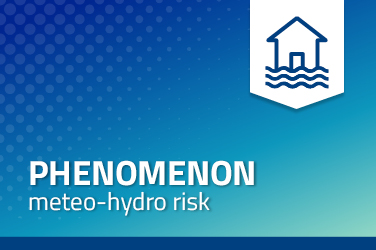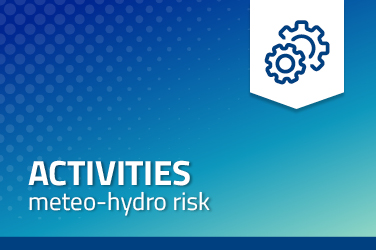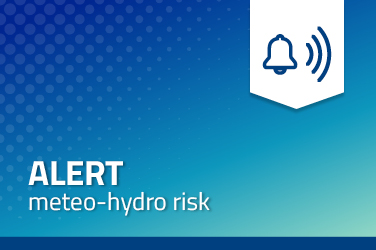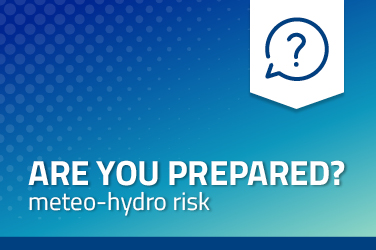Hydro-metereological risk

Hydro-metereological risk is used to identify the phenomena triggered by “unfavorable weather conditions” and the effective or potential damage caused by waters in general, be they surface, in liquid or solid form, or underground.
The most typical examples of these phenomena include thunderstorms, winds and sea storms, fog, snow and ice, heat waves, landslides, floods, coastal erosion, subsidence, and avalanches.
The hydro-metereological risk is also strongly influenced by human activity.
The density of population, the ever-progressing urbanization, abandonment of mountain areas, unauthorized buildings, continuous deforestation, the use of non-eco-friendly agricultural techniques, and the missing maintenance and upkeep of river beds and slopes have definitely worsened the hydrogeological instability and highlighted the fragility of our territory.
Meteorological risk
Weather conditions, in all their forms, profoundly affect human activities.
In some instances, weather phenomena assume a character of particular intensity and can pose a danger involving damage to property or people. In general, this is referred to as adverse weather conditions. It is, therefore, important to differentiate between risks due directly to weather phenomena and those arising from the interaction of weather events with other factors that characterize the territory or human activities.
These risks are then treated by the scientific fields that study those particular issues subject to the impact of weather conditions.
For example, heavy rainfall combined with peculiar local conditions can contribute to landslides or floods. In this case, we talk about hydrogeological or hydraulic hazards.
While conditions of high temperatures, low air humidity, and strong winds, combined with vegetation and soil features, can encourage the spread of fires in forest or rural areas. In this case, we talk about fire risk.
At the same time, conditions of very high temperatures (in summer) or very low temperatures (in winter), combined with particular air humidity and wind intensity levels, can pose a danger to people's health, especially for those suffering from specific diseases. In this case, we talk about health risks from heat waves or severe colds.
Lastly, heavy snowfalls in mountain areas, followed by particular temperature and/or wind conditions at high altitudes, in certain situations of ground morphology and slope exposure can give rise to the movement of large masses of snow-avalanches-that descend more or less rapidly down the valley, with the risk of sweeping people away or involving roads and houses.
Other weather-related risks, on the other hand, result from weather phenomena capable of directly causing damage to property or people. In particular, the phenomena that require the most attention are thunderstorms, winds and storm surges, fog, and snow/ice.
Hydrogeological and hydraulic risk
Hydrogeology is the geosciences discipline that studies groundwater in relation to surface water. However, in common understanding, hydrogeological instability is used to define the actual or potential phenomena and damage caused by water in general, regardless of whether it is surface water, liquid or solid form, or groundwater. The most common occurrences of hydrogeological phenomena are landslides, floods, coastal erosion, subsidence, and avalanches.
In the warning system, the risk is distinguished and defined as:
▪ Hydrogeological risk, which refers to the effects caused on the territory by the exceeding of critical rainfall levels along the slopes, hydrometric levels of the watercourses of the minor hydrographic network, and rainwater disposal.
▪ Hydraulic risk, which refers to the effects caused on the territory by exceeding critical hydrometric levels (possible flood events) along the main watercourses.
In Italy, hydrogeological instability is widely spread and represents a problem of considerable significance.
Among the natural factors that make our territory susceptible to hydrogeological instabilities is its geological and geomorphological conformation, characterized by complex orography (distribution of mountains) and generally small watersheds, which are, therefore, characterized by extremely fast rainfall response times. The time between the beginning of rainfall and flooding in the watercourse can be brief. Localized and intense meteorological events combined with these land features can result in violent phenomena characterized by rapid mudflows and flash floods.
Hydrogeological risk is also strongly influenced by human activity. Population density, increasing urbanization, the abandonment of mountain lands, unauthorized building, continuous deforestation, the adoption of environmentally unfriendly agricultural techniques, and the lack of maintenance of slopes and watercourses have certainly aggravated instability and further stressed the fragile nature of the Italian territory and increased exposure to the phenomena and thus the risk itself.
The occurrence of episodes of hydrogeological instability, which often have caused loss of life and extensive property damage, requires a policy of forecasting and prevention that no longer focuses on repairing damage and providing benefits but on identifying risk conditions and acting to reduce it.
Regulatory measures have required the delimitation of areas at risk and the development of a system of warning and surveillance that, together with adequate municipal civil protection planning, is a crucial resource for risk reduction where structural measures cannot be taken.



